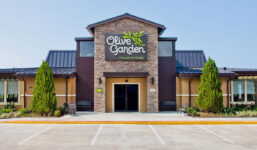
How Olive Garden Plans to Win Back Guests with Value-Driven Messaging
For the past five years, Olive Garden has intentionally priced below competitors. In fact, the casual-dining giant has priced more than 800 basis points below the full-service industry average and 700 basis points below grocery inflation.
But, admittedly, the leadership team knows it needs to do a better job of communicating value to customers. In the first quarter, Olive Garden saw its traffic gap to the industry go negative after years of outperformance. Also, same-store sales dipped 2.9 percent, consisting of 1.9 percent pricing and a drop of roughly 5 percent in traffic.
Darden CEO Rick Cardenas noted Olive Garden has seen declines in first-time guests, so several customers may not realize the brand is pricing below competitors. In response, the chain will prominently feature more price points in commercials during fiscal 2025, compared to last year when the messaging was mostly around equity building.
“I think we want to be thoughtful about how we do marketing, and you saw that when we find that there is something that we can get a return on, we’re willing to make the investment,” said Cardenas, discussing Olive Garden’s push for more advertising. “It’s not that there is any constraint on the spend. It’s more about, do we think we can get the return on it and we are just being more methodical. We’ve always said, we are playing a long game. We’re not trying to just win in the short term. We’re trying to focus on the long-term health of the business and how do we build it over time.”
READ MORE:
Olive Garden is Joining the Delivery Rush on its Own Terms
Olive Garden Partners with Uber Eats after Years of Turning Down Delivery
Lower-Income Guests are Leaving Olive Garden, but Darden isn’t Worried
Darden Has No Need for Discounting or Loyalty Programs
Olive Garden has a traditional national TV program, but the chain has also used smart TVs to capture streaming audiences. Darden has used learnings from Olive Garden to test this method at LongHorn, Yard House, and Cheddar’s Scratch Kitchen. The company has found this digital marketing strategy to be a “targeted efficient way to drive brand equity and incremental sales across all our brands,” Cardenas said.
Olive Garden will showcase value in different ways. The biggest example is the limited-time Never Ending Pasta Bowl, priced at $13.99. When the brand noticed drops in traffic, it moved up the promotion and scheduled it for a 12-week run (August 26 to November 17), which is three weeks longer than planned and four weeks longer than last year. Additionally, the company will introduce a new garlic herb sauce during the fifth week of the promotion.
“The starting-out price point hasn’t changed in three years, making it an even more compelling value, and Olive Garden is putting additional marketing support behind it,” Cardenas said.
Customers are visiting Olive Garden for the Never Ending Pasta Bowl more than usual, but not dramatically. Sixty to 65 percent of guests order protein on top of the pasta, which is more than last year. During this promotion, the company typically gets a lift from consumers across all income cohorts up to $150,000.
The CEO clarified that this move doesn’t signify a return to constant deep discounting. Olive Garden moved away from that before COVID, and the brand plans to keep it that way.
“Olive Garden is shifting some of their marketing message to highlight the value guests can get at Olive Garden, especially for first-time and infrequent users by bringing back fan favorites, whether at a limited time or on their core menu, that are simple to execute and that are improvement for what they had before,” Cardenas said. “This will give guests a little bit more compelling reasons to visit than talking about our core equities, which are great to build long term, but in this environment, we want to motivate guests to get back.”
Cardenas also emphasized that Olive Garden isn’t losing first-time users to other brands that are using deep discounting. The chain still has the same market share, but the total number of visits has dipped.
“That’s one little insight that we have—we’re not really losing, and neither is Cheddar’s, neither are other brands,” Cardenas said. “They’re not losing their guests to these discounts. These companies that are doing discounts might be taking share from other companies that are doing discounts. What are we doing? We are out there talking more about the great price that you can get at Olive Garden all the time, but motivating them a little bit more by saying, yeah, you get these prices all the time with unlimited first course, but some of these items if you want them you have to come in a little quicker.”
Cardenas indicated that additional limited-time offers may come in the back half of fiscal 2025, but he also assured they would still fit Darden’s marketing filters—simple to execute, not a deep discount, and strengthen the restaurants’ competitive advantages.
Darden began seeing declines in July for a variety of reasons—weather, the Olympics, increases in COVID, growth in international travel, and political volatility. Sales picked up in August, which is true of every brand in Darden’s portfolio.
“July was just something that was unexpected, and we feel like we’re going to be able to react in the right ways and we got that month behind us,” Cardenas said.
In Q1, system sales grew from $2.79 billion to $2.97 billion, and segment profit increased slightly from $293 million to $294.7 million.



